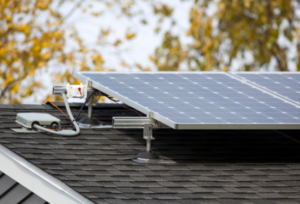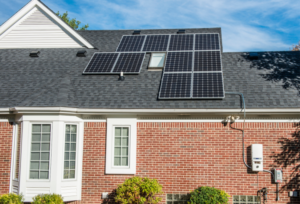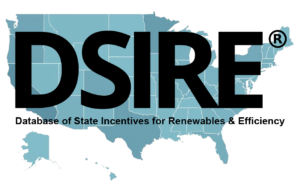Tips for Financing A Successful & Sustainable Residential Solar Photovoltaic System
 Across the United States, more and more homeowners are taking advantage of solar energy to power their lives. The cost of installing solar photovoltaic (PV) panels has fallen, and now millions of Americans have the opportunity to reduce their electric bills and more affordably invest in generating their own clean energy. Purchasing a solar PV (or solar thermal) system can run in the tens of thousands of dollars so it’s smart to be as informed and shop around for the best deal, as if you were purchasing a home, automobile, or college education.
Across the United States, more and more homeowners are taking advantage of solar energy to power their lives. The cost of installing solar photovoltaic (PV) panels has fallen, and now millions of Americans have the opportunity to reduce their electric bills and more affordably invest in generating their own clean energy. Purchasing a solar PV (or solar thermal) system can run in the tens of thousands of dollars so it’s smart to be as informed and shop around for the best deal, as if you were purchasing a home, automobile, or college education.
How to be a smart solar customer
Most Americans have options when making the decision to go solar and can maximize their benefits by finding the best fit for them. Before they can start benefiting from homemade solar power however, interested solar customers have a lot to consider- from learning about the basics of solar energy to determining your solar rooftop potential, finding the right solar installer, financing your solar system, and more.
 “The process of going solar can be complex for individual homeowners, so a relationship with a qualified, certified and experienced solar installer is key to streamlining the process, explained Isaac Panzarella, Assistant Director for Technical Services at the NC Clean Energy Technology Center (NCCETC). “When choosing a solar installer, look for locally owned companies with experience installing solar equipment and credentials to back them up,” Panzarella said.
“The process of going solar can be complex for individual homeowners, so a relationship with a qualified, certified and experienced solar installer is key to streamlining the process, explained Isaac Panzarella, Assistant Director for Technical Services at the NC Clean Energy Technology Center (NCCETC). “When choosing a solar installer, look for locally owned companies with experience installing solar equipment and credentials to back them up,” Panzarella said.
The North American Board of Certified Energy Practitioners® (NABCEP®) is the most respected, well-established and widely recognized certification organization for professionals in the field of renewable energy. Solar energy customers who hire a NABCEP Board Certified Professional can benefit from NABCEP’s high standards of ethical and professional practice. Interested customers can also search through the Better Business Bureau (BBB) Accredited Business marketplace to find a trustworthy business that operates with integrity and excellence in accordance with BBB Accreditation.
 David Del Vecchio, a solar instructor at NCCETC, encouraged those interested in installing solar to get several quotes from solar companies before making their final decision. “You should get at least two or three quotes and make sure one of them is from a local solar company with experienced installers,” he advised. “Look for installers with more than three years of experience and NABCEP certification.” Del Vecchio also stressed that reputable companies should be upfront about the entire process and able to answer any questions you may have throughout.
David Del Vecchio, a solar instructor at NCCETC, encouraged those interested in installing solar to get several quotes from solar companies before making their final decision. “You should get at least two or three quotes and make sure one of them is from a local solar company with experienced installers,” he advised. “Look for installers with more than three years of experience and NABCEP certification.” Del Vecchio also stressed that reputable companies should be upfront about the entire process and able to answer any questions you may have throughout.
“A reputable solar installer will guide you through the entire process and can properly size the system for you, but there’s a lot you can do before consulting them to determine your home’s solar potential,” added Panzarella. He explained potential consumers should calculate their electricity needs by reviewing past electricity bills and consider their electricity rates before making a final decision.
 Solar rooftop potential for an individual rooftop is the amount of solar that could be installed on a rooftop, based on its size, shading, tilt, location and construction. For individual homeowners, national laboratories and private companies have developed a number of tools to estimate the amount of solar that could be installed on a given rooftop. has funded in part these tools to help consumers start the process of choosing solar by determining the solar potential of their homes or businesses.
Solar rooftop potential for an individual rooftop is the amount of solar that could be installed on a rooftop, based on its size, shading, tilt, location and construction. For individual homeowners, national laboratories and private companies have developed a number of tools to estimate the amount of solar that could be installed on a given rooftop. has funded in part these tools to help consumers start the process of choosing solar by determining the solar potential of their homes or businesses.
To help lower installation costs, many states offer tax credits and incentives that can make solar a more cost-effective energy option for homeowners. There are also federal and utility financial incentives available. If their solar system qualifies for the federal energy investment tax credit, taxpayers can claim a 26 percent tax credit for solar systems installed before January 1, 2023 with the residential renewable energy tax credit.
“There are other options like, home equity loans, private loans or leasing for those unable to pay cash solar on their homes. The marketing for some of these services use misleading terms like ‘bill swap’ or ‘no-cost solar’ to make the investment look very attractive, so buyer beware,” said Panzarella. With any kind of financing you should evaluate how much you will be paying over the course of a typical year versus the estimated annual electric bill cost savings to make sure it’s a smart investment. There is no guarantee of net cost savings unless it is explicitly stated in the contract, so homeowners should make sure all key financing terms are clearly understood and stated before signing.
 Homeowners can also visit the Database of State Incentives for Renewables & Energy Efficiency (DSIRE) to learn more about federal, state and utility policies and incentives for solar energy and energy storage. Maintained and operated by the NCCETC, DSIRE is the most comprehensive source of information on clean energy related policies and incentives in the United States with summaries of more than 2,600 incentives and policies.
Homeowners can also visit the Database of State Incentives for Renewables & Energy Efficiency (DSIRE) to learn more about federal, state and utility policies and incentives for solar energy and energy storage. Maintained and operated by the NCCETC, DSIRE is the most comprehensive source of information on clean energy related policies and incentives in the United States with summaries of more than 2,600 incentives and policies.
DSIRE teamed up with EnergySage, an online comparison shopping marketplace for solar, to offer consumers the option to seamlessly move from education and research, to evaluating their solar options online. Visitors to dsireusa.org can do so with help from a number of different resources such as a Solar Calculator for quickly estimating solar savings and access to a Solar Marketplace where consumers can easily comparison-shop multiple quotes from vetted installers with assistance from impartial Solar Advisors. These tools will help DSIRE users make informed decisions and pay a fair price for the right quality solar panel system.
 DSIRE also tracks net metering rules across the United States. For electric customers who generate their own electricity, net metering allows for the flow of electricity both to and from the customer. When a customer’s generation exceeds the customer’s use, electricity from the customer flows back to the grid, offsetting electricity consumed by the customer at a different time during the same billing cycle. For example, if a residential customer’s PV system generates more electricity than their home uses during daylight hours, the electricity meter will run backwards to provide a credit against what electricity is consumed at night or other periods when the home’s electricity use exceeds the system’s output.
DSIRE also tracks net metering rules across the United States. For electric customers who generate their own electricity, net metering allows for the flow of electricity both to and from the customer. When a customer’s generation exceeds the customer’s use, electricity from the customer flows back to the grid, offsetting electricity consumed by the customer at a different time during the same billing cycle. For example, if a residential customer’s PV system generates more electricity than their home uses during daylight hours, the electricity meter will run backwards to provide a credit against what electricity is consumed at night or other periods when the home’s electricity use exceeds the system’s output.
 OTHER RESOURCES
OTHER RESOURCES
The Solar Energy Industries Association’s Residential Consumer Guide to Solar Power informs potential solar customers about the financing options available, contracting terms to be aware of, and other useful tips. The guide also includes key questions to ask before entering into an agreement to ensure there isn’t any mystery or confusion before the official contract is signed.
Navigating the solar financing options now available has become increasingly complex. The Clean Energy States Alliance has a guide to help homeowners understand their options and make informed decisions about financing solar. View the guide now.
If you’re interested in taking the next step to go solar, visit SETO’s webpage for Solar Energy Resources for Consumers to learn more. North Carolinians can find specific information for their state in the NC Sustainable Energy Association’s Consumer Guide to Solar Electricity for the North Carolina Homeowner.